
Galileo was an American robotic space program that studied the planet Jupiter and its moons, as well as several other Solar System bodies. Named after the Italian astronomer Galileo Galilei, the Galileo spacecraft consisted of an orbiter and an atmospheric entry probe. It was delivered into Earth orbit on October 18, 1989, by Space ShuttleAtlantis on the STS-34 mission, and arrived at Jupiter on December 7, 1995, after gravity assist flybys of Venus and Earth, and became the first spacecraft to orbit Jupiter. The spacecraft then launched the first probe to directly measure its atmosphere. Despite suffering major antenna problems, Galileo achieved the first asteroid flyby, of 951 Gaspra, and discovered the first asteroid moon, Dactyl, around 243 Ida. In 1994, Galileo observed Comet Shoemaker–Levy 9's collision with Jupiter.
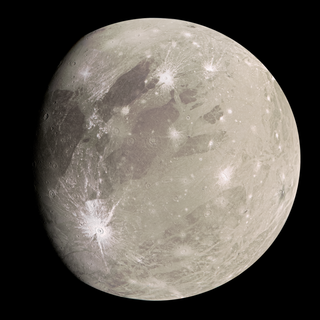
Ganymede, or Jupiter III, is the largest and most massive natural satellite of Jupiter, and in the Solar System. Despite being the only moon in the Solar System with a substantial magnetic field, it is the largest Solar System object without a substantial atmosphere. Like Saturn's largest moon Titan, it is larger than the planet Mercury, but has somewhat less surface gravity than Mercury, Io, or the Moon due to its lower density compared to the three. Ganymede orbits Jupiter in roughly seven days and is in a 1:2:4 orbital resonance with the moons Europa and Io, respectively.
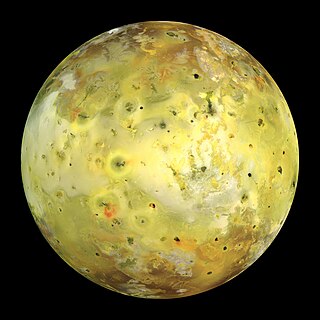
Io, or Jupiter I, is the innermost and second-smallest of the four Galilean moons of the planet Jupiter. Slightly larger than Earth's moon, Io is the fourth-largest moon in the Solar System, has the highest density of any moon, the strongest surface gravity of any moon, and the lowest amount of water by atomic ratio of any known astronomical object in the Solar System. It was discovered in 1610 by Galileo Galilei and was named after the mythological character Io, a priestess of Hera who became one of Zeus's lovers.

Juno is a NASA space probe orbiting the planet Jupiter. It was built by Lockheed Martin and is operated by NASA's Jet Propulsion Laboratory. The spacecraft was launched from Cape Canaveral Air Force Station on August 5, 2011 UTC, as part of the New Frontiers program. Juno entered a polar orbit of Jupiter on July 5, 2016, UTC, to begin a scientific investigation of the planet. After completing its mission, Juno was originally planned to be intentionally deorbited into Jupiter's atmosphere, but has since been approved to continue orbiting until contact is lost with the spacecraft.
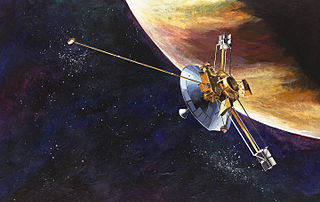
The exploration of Jupiter has been conducted via close observations by automated spacecraft. It began with the arrival of Pioneer 10 into the Jovian system in 1973, and, as of 2024, has continued with eight further spacecraft missions in the vicinity of Jupiter and two more en route. All but one of these missions were undertaken by the National Aeronautics and Space Administration (NASA), and all but four were flybys taking detailed observations without landing or entering orbit. These probes make Jupiter the most visited of the Solar System's outer planets as all missions to the outer Solar System have used Jupiter flybys. On 5 July 2016, spacecraft Juno arrived and entered the planet's orbit—the second craft ever to do so. Sending a craft to Jupiter is difficult, mostly due to large fuel requirements and the effects of the planet's harsh radiation environment.
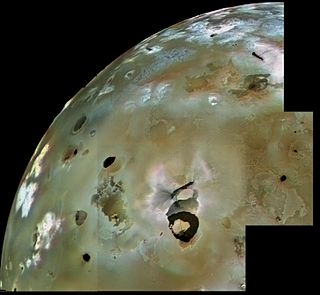
Loki Patera is the largest volcanic depression on Jupiter's moon Io, 202 kilometres (126 mi) in diameter. It contains an active lava lake, with an episodically overturning crust. The level of activity seen is similar to a superfast spreading mid-ocean ridge on Earth. It is the largest volcano on Io, producing about 10% of Io’s total thermal emission. Temperature measurements of thermal emission at Loki Patera taken by Voyager 1's Infrared Interferometer Spectrometer and Radiometer (IRIS) instrument were consistent with sulfur volcanism.
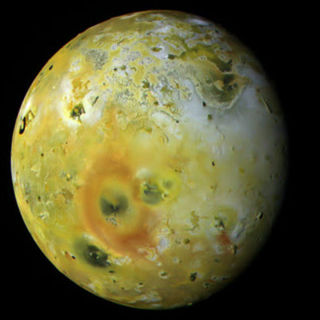
Pele is an active volcano on the surface of Jupiter's moon Io. It is located on Io's trailing hemisphere at 18.7°S 255.3°W. A large, 300-kilometer (190 mi) tall volcanic plume has been observed at Pele by various spacecraft starting with Voyager 1 in 1979, though it has not been persistent. The discovery of the Pele plume on March 8, 1979 confirmed the existence of active volcanism on Io. The plume is associated with a lava lake at the northern end of the mountain Danube Planum. Pele is also notable for a persistent, large red ring circling the volcano resulting from sulfurous fallout from the volcanic plume.

Volcanism on Io, a moon of Jupiter, is represented by the presence of volcanoes, volcanic pits and lava flows on the surface. Io's volcanic activity was discovered in 1979 by Linda Morabito, an imaging scientist working on Voyager 1. Observations of Io by passing spacecraft and Earth-based astronomers have revealed more than 150 active volcanoes. As of 2024, up to 400 such volcanoes are predicted to exist based on these observations. Io's volcanism makes the satellite one of only four known currently volcanically or cryovolcanically active worlds in the Solar System
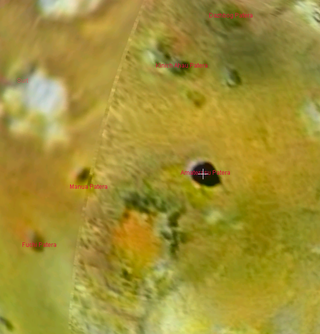
Amaterasu Patera is a patera, a complex crater with scalloped edges, on Jupiter's moon Io. It is one of the darkest features on Io, and the measurement of its thermal spectrum helped to support an anticorrelation between albedo and temperature for Ionian hotspots. The feature has darkened further since the first orbit around Jupiter by the Galileo spacecraft. It is 100 kilometers in diameter and located at 38.1°N 306.5°W. It was named after the Japanese sun goddess Amaterasu. To the north are Kinich Ahau Patera and Dazhbog Patera, and to the west are Manua Patera and Fuchi Patera.

Asha Patera is a patera, or a complex crater with scalloped edges, on Jupiter's moon Io. It is approximately 108 kilometers in diameter and located at 8.84°S 225.69°W. It is named after asha, the Zoroastrian principle of Truth. Its name was adopted by the International Astronomical Union in 1979. Reiden Patera and Kami-Nari Patera can both be found to the west.

Kami-Nari Patera is a patera, or a complex crater with scalloped edges, on Jupiter's moon Io. It is approximately 53 kilometers in diameter and is located at 8.7°S 235.08°W. It is named after the Japanese god of rolling thunder, Kami-Nari. Its name was adopted by the International Astronomical Union in 2000. Reiden Patera can be found to the south, and Asha Patera can be found to the east.

Ah Peku Patera is a patera, or a complex crater with scalloped edges, on Jupiter's moon Io. It is 85 kilometers in diameter and is located at 10.3°N 107°W. It is named after the Mayan thunder god Ah Peku. Its name was adopted by the International Astronomical Union in 2006. Ah Peku Patera is located on the south end of Monan Mons, north of which is Monan Patera. The eruptive centers Amirani and Maui can be found northwest, as well as Maui Patera. Gish Bar Patera is located toward the northeast. Ah Peku Patera was first detected by the spacecraft Galileo's Solid State Imager and Near-Infrared Mapping Spectrometer. It is considered an active hot spot.

Gish Bar Patera is a patera, or a complex crater with scalloped edges, on Jupiter's moon Io. It is 106.3 by 115.0 kilometers and 9,600 km2 in area. It is located at 16.18°N 90.26°W. It is named after the Babylonian sun god Gish Bar. Its name was approved by the International Astronomical Union in 1997. It is located at the southern base of Gish Bar Mons, an 11-kilometer-high mountain. To the northeast is Skythia Mons, and to the east is Monan Mons, at the north and south ends of which are Monan Patera and Ah Peku Patera.

Svarog Patera is a patera, or a complex crater with scalloped edges, on Jupiter's moon Io. It is 124 kilometers in diameter and is located at 48.66°S 265.74°W. It is named after the Russian smith god Svarog. Its name was approved by the International Astronomical Union in 1979. Svarog Patera is a Voyager spacecraft-detected hot spot. North of Svarog Patera is Lyrcea Planum, north of which is Babbar Patera. To the south is Silpium Mons, and to the east is Hermes Mensa. To the southeast are Pyerun Patera and Epaphus Mensa.

Viracocha Patera is a patera, or a complex crater with scalloped edges, on Jupiter's moon Io. It is about 61 kilometers in diameter and is located at 61.75°S 280.07°W. It is named after the Quechua creator god Viracocha. The name was adopted by the International Astronomical Union in 1979. Viracocha Patera is a Voyager spacecraft-detected hot spot. To Viracocha Patera's east-northeast is Mithra Patera, and to the northeast is the mountain Silpium Mons.

Amirani is an active volcano on Jupiter's moon Io, the inner-most of the Galilean Moons. It is located on Io's leading hemisphere at 24.46°N 114.68°W. The volcano is responsible for the largest active lava flow in the entire Solar System, with recent flows dwarfing those of even other volcanos on Io.

Tupan Patera is an active volcano on Jupiter's moon Io. It is located on Io's anti-Jupiter hemisphere at 18.73°S 141.13°W. Tupan consists of a volcanic crater, known as a patera, 79 kilometers across and 900 meters deep. The volcano was first seen in low-resolution observations by the two Voyager spacecraft in 1979, but volcanic activity was not seen at this volcano until June 1996 during the Galileo spacecraft's first orbit. Following this first detection of near-infrared thermal emission and subsequent detections by Galileo during the next few orbits, this volcano was formally named Tupan Patera, after the thunder god of the Tupí-Guaraní indigenous peoples in Brazil, by the International Astronomical Union in 1997.

Tawhaki Patera is an active volcano on Jupiter's moon Io. It is located on Io's leading hemisphere at 3.32°N 76.18°W within the equatorial plains of western Media Regio. Tawhaki is an Ionian patera, a type of volcanic crater similar to a caldera, 49.8 kilometers (30.9 mi) wide and 550 meters (1,800 ft) deep.

The exploration of Io, Jupiter's innermost Galilean and third-largest moon, began with its discovery in 1610 and continues today with Earth-based observations and visits by spacecraft to the Jupiter system. Italian astronomer Galileo Galilei was the first to record an observation of Io on January 8, 1610, though Simon Marius may have also observed Io at around the same time. During the 17th century, observations of Io and the other Galilean satellites helped with the measurement of longitude by map makers and surveyors, with validation of Kepler's Third Law of planetary motion, and with measurement of the speed of light. Based on ephemerides produced by astronomer Giovanni Cassini and others, Pierre-Simon Laplace created a mathematical theory to explain the resonant orbits of three of Jupiter's moons, Io, Europa, and Ganymede. This resonance was later found to have a profound effect on the geologies of these moons. Improved telescope technology in the late 19th and 20th centuries allowed astronomers to resolve large-scale surface features on Io as well as to estimate its diameter and mass.

Thor is an active volcano on Jupiter's moon Io. It is located on Io's anti-Jupiter hemisphere at 39.15°N 133.14°W. A major eruption with high thermal emission and a large, volcanic plume was observed during a Galileo flyby on August 6, 2001, when the spacecraft flew through the outer portions of the plume allowing for direct sampling. The eruption continued into Galileo's next flyby in October 2001. As seen during high-resolution images taken during the eruption, Thor consists of a series of dark lava flows emanating from a set of nearby volcanic depressions. Before the eruption, the area consisted of red-brown plains, composed of irradiated sulfur, typical of Io's mid- to high-northern latitudes and a set of yellow flows, possibly consisting of sulfur or silicate flows covered by diffuse sulfur deposits. During the New Horizons encounter in February 2007, Thor was still active, with the spacecraft observing thermal emission in the near-infrared and a volcanic plume at the volcano.


















